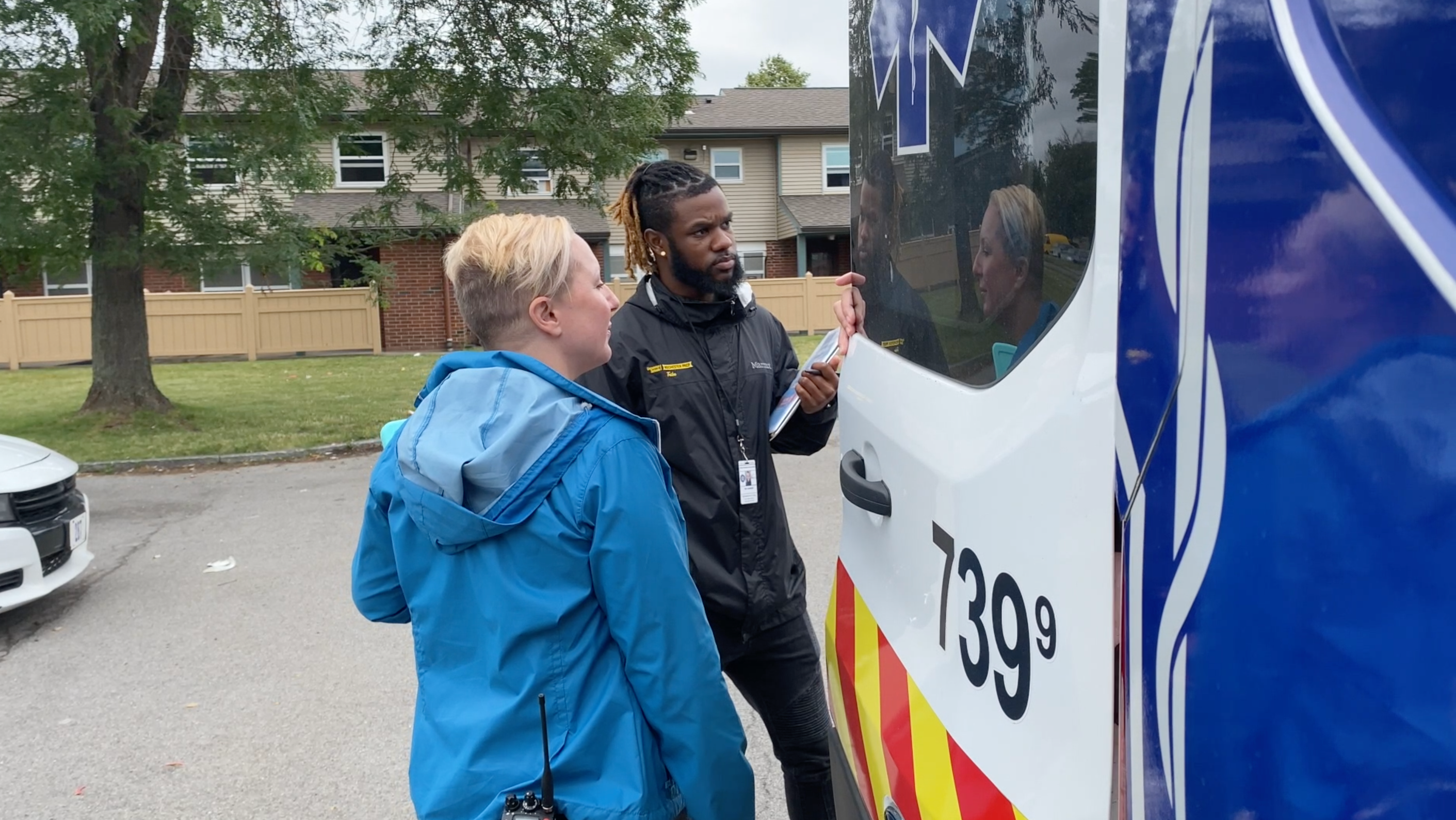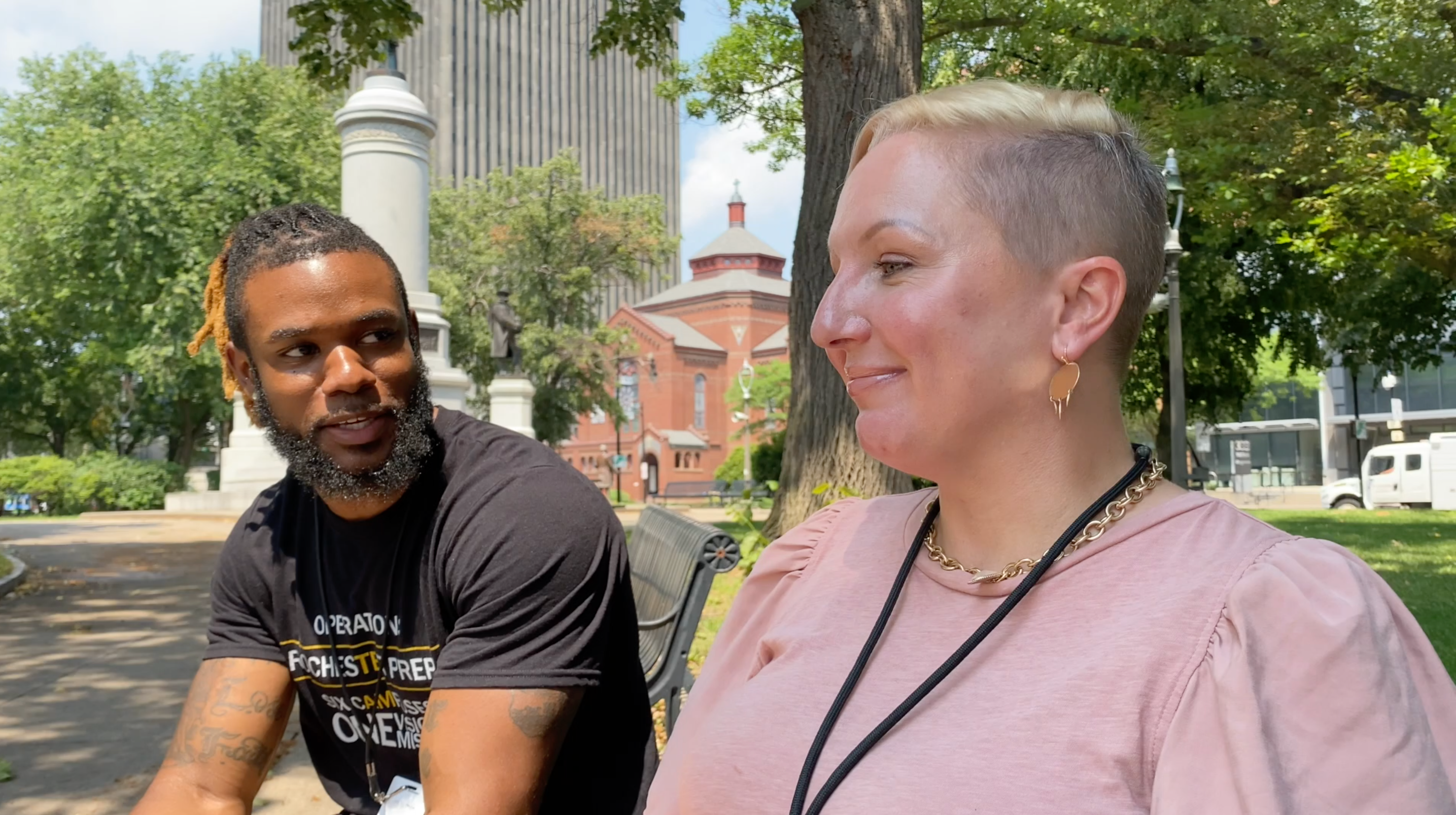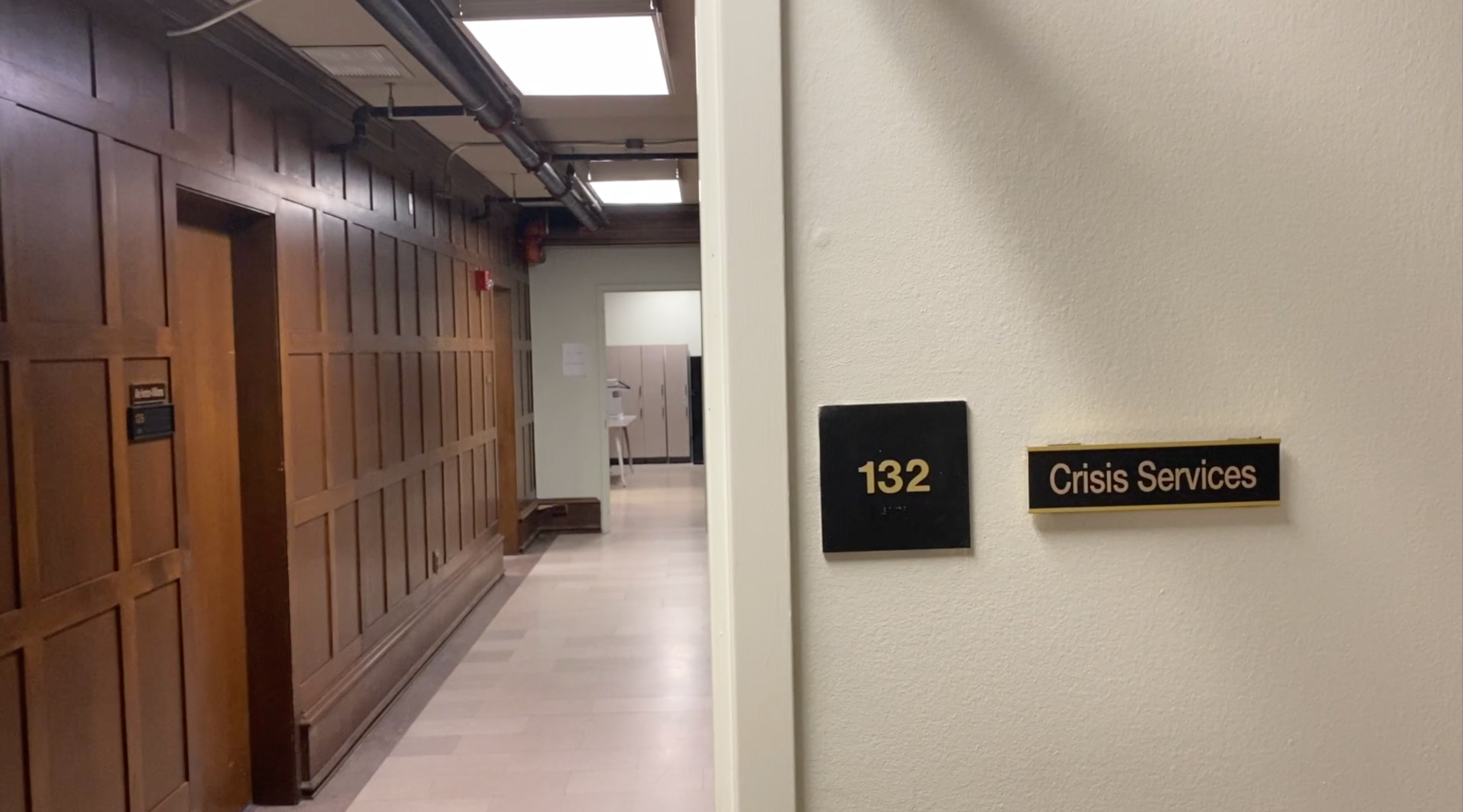This city de-funded the police. Here’s what happened next
In a city that was rocked by the killing of Daniel Prude during a mental health episode, Richard Hall rides along with a new team that hopes to reimagine policing

At the side of a busy road in the city of Rochester, New York, a man is pacing up and down with a phone in his hand. He is sweating profusely and clearly in distress. Two police cars have already arrived and an uneasy stand-off with several officers is underway, but the man cannot be calmed.
It’s an all-too-familiar scene in a city that suffers from severe homelessness and the problems that come with it. But it is about to be interrupted by a pair of less familiar characters. They are carrying clipboards, rather than guns.
Social workers Dre’ Johnson and Renee Brean are part of a pioneering new approach to policing in this city in the far north of New York state. They belong to Rochester’s “person in crisis” team – a unit of mental health and behavioural professionals who attend police calls where a person may be suffering a mental health episode.
In the aftermath of nationwide protests over the police killing of George Floyd, activists across the country made calls to defund, reform and reimagine policing. Here in Rochester, the city is doing just that. It has cut funding for police and diverted that money to the person in crisis team and other public safety measures.
The reform effort here was sparked by a police killing strikingly similar to Mr Floyd’s, and much closer to home. The city was already in the midst of racial justice protests when the video of Daniel Prude’s death emerged in September last year. It showed the 41-year-old Black man being restrained by police in the street with a hood over his head until he became unconscious. He was naked, confused and clearly suffering a mental health episode. He died in hospital days later.
His death, which was later ruled a homicide, galvanised protesters and forced authorities to take action. In response, the city sought a new way of handling police calls involving mental health issues. The person in crisis team was born.
“I’m from this community, and people from this community have spoken after they saw how police treated Daniel Prude. That’s what birthed our programme,” says Johnson, in between calls.
“I don’t think it’s taking a shot at the police to say that people weren’t happy with the responses they were getting when it came to mental health, or substance abuse and homelessness,” he adds. “There was a void and we’re filling that void.”
The premise behind the person in crisis team is simple: it contends that for all their training and skills, police are not equipped to deal with the complexities that a mental health crisis requires. By sending mental health professionals along to 911 calls that may involve potential psychological breakdowns, officials hope that these situations can be dealt with more sensitively, and more safely.
“These folks really are having one of the most difficult days of their life,” says Johnson of the people they see on calls, “and it doesn’t need to be compounded by a fear of being hurt by someone who isn’t trained or has the background or skill set to work with that person”.
“That’s no disrespect to the police. If we have a situation where there’s a bank robbery, we want the police there to do their job. If we have a situation where someone is having a psychotic break, we want a mental health professional there to do their job.”
What is happening in Rochester may have nationwide implications. The backlash to calls to defund the police have often been framed as a threat to public safety. But this city appears to be doing it in a way that improves it.
In 2020, the city passed a budget that cut police funding of $95 million by 4 per cent. It also reallocated $130,000 set aside for police overtime to youth services. This year it again cut police funding by some $4.5 million (£3.2 million), with money being diverted to expanding the person in crisis team, which was officially launched in February after a pilot programme.
The Independent spent two days with the team as they responded to calls across the city. The ride-a-long offered a window into the kind of alternative policing that racial justice protesters across the country have been calling for, and which many hope could be replicated. This is what de-funding the police looks like.

Rochester is a city of around 200,000 people on the southern shore of Lake Ontario, just over the border from Canada. It was once a boomtown, home to giant corporations like Kodak and Xerox, but with the collapse of industry and population decline over the decades, it is now one of the most impoverished cities in the entire country. It struggles with high levels of homelessness and poverty.
Brean and Johnson are part of a team of 30 staff members, all with similar backgrounds. Brean left a job at a local hospital to join the “pic team”. Johnson was working at a school in Florida. Both have Master’s degrees in social work and talk of the job as a “mission” – a long overdue one.
Johnson draws a direct line from the racial justice protests to his own journey back to his hometown and this community. He was part of those protests, and today he sees himself as part of the answer to them.
“For it to hit home here in Rochester, when we already had George Floyd going on in Minneapolis, it really struck a nerve in me,” he says of the Daniel Prude video.
“I’m a black man who grew up in this community, and have been stopped by police dozens of times and been mistreated by police dozens of times and had I been a white man I wouldn’t have been treated that way.”
The team works from a city building in the centre of Rochester, where they wait for calls to come in from police dispatch. Any time a 911 call is flagged as potentially involving a mental health issue, the people in crisis team is called out to go along with the police. The service runs 24/7, and they are currently receiving around 100 calls a week.
Brean says there is no typical call.
“It might be someone who is suicidal or homicidal, it might be someone who has run out of meds. We’ve responded to calls where there’s a domestic dispute between husband and wife, parents and children. Each crisis looks different.”
They work in pairs, much like police officers. The rhythm of their day is similar, too. But their methods could not be more different.
On calls, they play something of a mediating role between police and the person in crisis.
“Sometimes the people we serve feel uncomfortable with having the police there. They feel like whatever they are going through they are going to get, they feel like their mental health crisis is going to lead to them being in trouble,” Brean says.
“And really a lot of times either the person we are serving has experienced some kind of negative interaction with the police or someone they know. So we’re really trying to be mindful of their previous experiences.”
“If we’re paying tax dollars for someone to protect us, and we’re afraid to utilise that service, we’re afraid that the protection will cause harm, or make it worse, that’s an issue,” he says.

A call comes in as he talks and the dispatcher briefs the team over the radio. A man has called 911 after a woman he knew had climbed into the shower with her clothes on and appeared to be suffering some kind of mental breakdown.
Brean and Johnson head to the scene. Once they arrive, they have to wait for the police before they approach. When they do, the team works in tandem with them. Johnson tries to arrange a ride home for a woman in distress, while Brean takes care of the children who were playing on the street. They go between the police and the ambulance drivers before she is eventually taken to hospital.
To the untrained eye, it looks less of a new way of policing and more of an addition to it. On this call, Johnson outlines how their mediator role came into play.
“The officer seemed to get agitated with her because she wasn’t listening. I’ve seen many situations go awry because people were talking back,” he says.
“The way that we are taught from school is to be as least invasive as possible. The police are trained totally differently. They are trained to issue commands and people have to comply. It turns into a power struggle sometimes,” he adds.
While not quite reaching the level of a power struggle, there have been some growing pains between the people in crisis team and their police colleagues. Both Brean and Johnson say earning the trust of the officers has been a key aim.
Brean recounts a time when a police officer who had initially been sceptical of their work saw them in action and changed his mind.
“That was one of those moments that made my entire day,” she says. “But it’s been some work to get there.”
Johnson chimes in: “I feel like sometimes it’s been like pulling teeth to get them to say when we’ve done a good job. So when they are appreciative [...] it does help.”
The reaction from the public, they say, has been nothing but positive.
“I had a guy break down in tears and hug me after he was about to jump off a bridge,” says Johnson. “To see that level of appreciation… you have some rough days but those are the times that make it all worth it.”
One thing both of them are acutely aware of is the link between deprivation and where the calls are coming from.
Rochester has a poverty rate of 31 per cent. It is also a deeply unequal city, especially when economic indicators are broken down by race. Between 2007 and 2017, a landmark report ranked the city the worst in the country in the relative poverty gap between white and non-white workers.
It didn’t use to be like that. The city once attracted workers from across the country, but when corporations later faced downturns and left, Rochester’s economy went with them.
“A lot of those folks [who lost their jobs] were African American,” says Johnson. “They were getting paid good money and now you don’t have them, you have people left saying ‘what do we do?’”
While the person in crisis team is new, those involved have high hopes. They have been receiving visitors from other city authorities across the country, as well as state lawmakers.
“I would love to see our programme a part of the public safety sector,” Johnson says. “I would love to see it just be the norm. I think like when I was a kid and a cat used to run up in the tree, they would have firefighters come and get it out of the tree. That was because there was no animal control at that time. Then because they realised it wasn’t a good use of our funding — we need to create something else.
“So I would love in 10 years from now my kids to be growing up in a world where a person in crisis team exists in every city around the country.”
